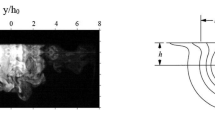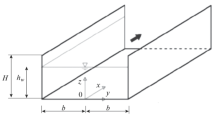Abstract
In the Reynolds equations with the Shear Stress Transport (SST) turbulence model, the numerical simulation of the effect of the energy input into the stream in front of the bow and the side surface on the base flow has been performed. For the regimes considered, it has been shown that the energy input before the bow, resulting in a significant reduction of wave resistance has little effect on the value of the base pressure. This ensures the efficiency of the energy input as a means of reducing the drag force. For the considered regimes, it has been shown that the input of energy around the lateral surface leads to a small increase in the base pressure.
Similar content being viewed by others
References
V. Chernikov, S. Dvinin, A. Ershov, V. Shibkov, I. Timofeev, and D. van Wie, “Experimental and theoretical research of DC transversal gas discharge in a supersonic gas flow,” in Proceedings of the 3rd Workshop on Magneto-Plasma Aerodynamics in Aerospace Applications, Ed. by V. A. Bityurin, (IVTAN, Moscow, 2001), pp. 129–134.
G. I. Mishin, A. I. Klimov, and A. Yu. Gridin, “Longitudinal electric discharge in supersonic gas flow,” Sov. Tech. Phys. Lett. 18, 506 (1992).
V. M. Fomin, A. V. Lebedev, and A. I. Ivanchenko, “Space-energy characteristics of electric discharge in supersonic gas flow,” Phys. Dokl. 43, 440–443 (1998).
V. Skvortsov, Yu. Kuznetsov, V. Litvinov, B. Efimov, V. Markin, A. Uspenskii, A. Khvostov, A. Golovnja, L. Vasilenko, P. Kuzjaev, A. Klimov, and S. Leonov, “Investigation of aerodynamic effects at the electric discharge creation on the models of different geometry,” in Proceedings of the 2rd Workshop on Magneto-Plasma Aerodynamics in Aerospace Applications, Ed. by V. A. Bityurin (IVTAN, Moscow, 2000), pp. 102–106.
L. P. Grachev, I. I. Esakov, and K. V. Khodataev, “Microwave streamer discharge in a supersonic air flow,” Tech. Phys. 44, 1271–1275 (1999).
Yu. F. Kolesnichenko, V. G. Brovkin, O. A. Azarova, V. G. Grudnitsky, V. A. Laskov, and I. Ch. Mashek, “MW energy deposition for aerodynamic application,” in Proceedings of the 41st Aerospace Science Meeting and Exhibit, Reno, Nevada, USA, January 6–9, 2003, AIAA Paper No. 2003-361.
V. M. Shibkov, A. V. Chernikov, V. A. Chernikov, A. P. Ershov, L. V. Shibkova, I. B. Timofeev, D. A. Vinogradov, and A. V. Voskanyan, “Surface microwave discharge in supersonic airflow,” in Proceedings of the 2rd Workshop on Magneto-Plasma Aerodynamics in Aerospace Applications, Ed. by V. A. Bityurin (IVTAN, Moscow, 2000), pp. 163–168.
P. K. Tret’yakov, A. F. Garanin, G. N. Grachev, V. L. Krainev, A. G. Ponomarenko, A. I. Ivanchenko, and V. I. Yakovlev, “Control of supersonic flow around bodies by means of high-power recurrent optical breakdown,” Phys. Dokl. 41, 566 (1996).
S. Leonov, V. Bityurin, A. Yuriev, S. Pirogov, and B. Zhukov, “Problems in energetic method of drag reduction and flow/flight control,” in Proceedings of the 41st Aerospace Science Meeting and Exhibit, Reno, Nevada, USA, January 6–9, 2003, AIAA Paper No. 2003-35.
P. Tretyakov, “Supersonic flow around axisymmetric bodies with external supply of mass and energy,” in Proceedings of the 2rd Workshop on Magneto-Plasma Aerodynamics in Aerospace Applications, Ed. by V. A. Bityurin (IVTAN, Moscow, 2000), pp. 128–132.
G. G. Chernyi, Gas Dynamics, The School-Book for Universities and Higher Schools (Nauka, Moscow, 1988) [in Russian].
P. Yu. Georgievskii and V. A. Levin, “Supersonic flow about objects with external heat—evolution sources,” Sov. Tech. Phys. Lett. 14, 303 (1988).
P. Yu. Georgievskii and V. A. Levin, “Control of the flow past bodies using localized energy addition to the supersonic oncoming flow,” Fluid Dyn. 38, 794–805 (2003).
V. N. Zudov, P. K. Tret’yakov, A. V. Tupikin, and V. I. Yakovlev, “Supersonic flow past a thermal source,” Fluid Dyn. 38, 782–793 (2003).
V. P. Gordeev, A. V. Krasil’nikov, V. I. Lagutin, and V. N. Otmennikov, “Experimental study of the possibility of reducing supersonic drag by employing plasma technology,” Fluid Dyn. 31, 313–317 (1996).
V. A. Levin, V. G. Gromov, and N. E. Afonina, “Numerical analysis of the effect of local energy supply on the aerodynamic drag and heat transfer of a spherically blunted body in a supersonic air flow,” J. Appl. Mech. Tech. Phys. 41, 915–922 (2000).
A. I. Zubkov, A. F. Garanin, V. F. Safronov, L. D. Sukhanovskaya, and P. K. Tretyakov, “Supersonic flow past an axisymmetric body with combustion in separation zones at the body nose and base,” Thermophys. Aeromech. 12, 1–12 (2005).
P. K. Chang, Separation of Flow (Pergamon, New York, 1970).
A. I. Shvets and I. T. Shchvets, Gas Dynamics of Near Wakes (Naukova Dumka, Kiev, 1976; NASA, Washington DC, 1977).
L. V. Gogish and T. Yu. Stepanov, Turbulent Separated Flows (Nauka, Moscow, 1979) [in Russian].
B. N. Dan’kov, A. P. Kosenko, V. N. Kulikov, and V. N. Otmennikov, “Wave disturbances in transonic separated flows,” Fluid Dyn. 41, 992–1003 (2006).
I. Yu. Kudryashov and A. E. Lutsky, “Mathematical simulation of turbulent separated transonic flows around the bodies of revolution,” Math. Models Comput. Simul. 3, 690–696 (2011).
O. B. Larin and V. A. Levin, “Effect of energy supply to a gas on laminar boundary layer separation,” J. Appl. Mech. Tech. Phys. 51, 11–15 (2010).
A. A. Zheltovodov and E. A. Pimonov, “Numerical simulation of an energy deposition zone in quiescent air and in a supersonic flow under the conditions of interaction with a normal shock,” Tech. Phys. 58, 170–184 (2013).
F. Simon, S. Deck, and P. Guillen, “Reynolds-averaged Navier-Stokes/large-eddy simulations of supersonic base flow,” AIAA J. 44, 2578–2590 (2006).
F. R. Menter, “Zonal two-equation k-ω turbulence models for aerodynamic flows,” AIAA Paper No. 1993-2906.
P. Bradshaw, D. H. Ferriss, and N. P. Atwell, “Calculation of boundary layer development using the turbulent energy equation,” J. Fluid Mech. 28, 593–616 (1967).
Author information
Authors and Affiliations
Corresponding author
Additional information
Original Russian Text © I.Yu. Kudryashov, A.E. Lutsky, Ya.V. Khankhasaeva, 2015, published in Matematicheskoe Modelirovanie, 2015, Vol. 27, No. 9, pp. 33–48.
Rights and permissions
About this article
Cite this article
Kudryashov, I.Y., Lutsky, A.E. & Khankhasaeva, Y.V. Numerical simulation of the influence of energy deposition on the base flow. Math Models Comput Simul 8, 207–218 (2016). https://doi.org/10.1134/S2070048216020083
Received:
Published:
Issue Date:
DOI: https://doi.org/10.1134/S2070048216020083




